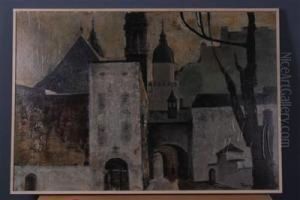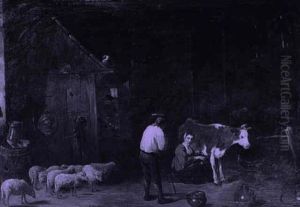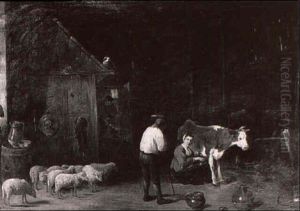Josef Prem Paintings
Josef Prem, born in 1899 and passing away in 1996, was not widely recognized outside the circles of those deeply invested in the exploration of European art movements of the 20th century. His life and work, however, offer a fascinating glimpse into the periods of turbulence and transformation that characterized this era in art history. Prem's journey as an artist began in the aftermath of World War I, a time when the artistic landscape was undergoing significant shifts, and new movements such as Expressionism, Dadaism, and later Surrealism, were emerging. These movements, with their emphasis on expressing the inner world of the artist and rejecting the conventional aesthetics of the time, would leave a lasting impact on Prem's artistic development.
Josef Prem's early work was deeply influenced by the Expressionist movement, characterized by its use of bold colors, dramatic expressions, and often, a critique of modern society. Like many artists of his generation, Prem was searching for a means to convey the emotional and psychological turmoil of the post-war period. His paintings from this period often depicted distorted figures and landscapes, reflecting the inner angst and disillusionment with the contemporary world.
As the years progressed, Prem's work began to evolve, showing influences of other contemporary movements, including Cubism and Surrealism. This evolution was indicative of his constant search for new ways of expression and his unwillingness to be confined within the boundaries of a single artistic movement. Despite this, he never gained the same level of recognition as some of his contemporaries. This was, perhaps, due to a combination of factors, including the political and economic turmoil in Europe, which overshadowed many artists' careers, and Prem's own reticence to engage with the commercial art world.
Throughout his life, Josef Prem remained dedicated to his art, exploring various mediums and techniques. His later works, produced in the mid-20th century, became more abstract, reflecting a deeper contemplation of form and color, and moving away from the more explicit social and emotional commentary of his earlier pieces. These works, while less known, contribute to the understanding of the trajectory of European art in the 20th century, demonstrating how artists negotiated the rapidly changing world around them.
Despite his death in 1996, Josef Prem's legacy lives on, particularly among art historians and collectors who appreciate the depth and breadth of his work. His artistic journey encapsulates the tumultuous journey of 20th-century art, from the raw, emotional outpourings of Expressionism to the introspective abstractions of the post-war period. Prem's life and work remind us of the power of art to reflect, critique, and transcend the times in which it is created.


